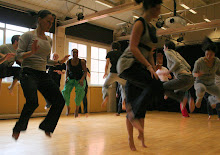1. One of the first devising strategies used in creating Porto helped to create our opening scene. A space was created with chairs, and our task was to enter the space when we felt it was right. We had all previously chosen an individual way of entering that was specific to our character. We also created work collaboratively as an ensemble (not completely the whole group), where we used the technique of clapping. When one person clapped, they offered a pedestrian gesture or movement that the rest of the ensemble duplicated to the exact detail. By the time we had 5 or 6 it had become a performance and had taken a mere ten minutes. This is a very efficient way of devising, as the need to talk is eliminated, and work is created rapidly and precisely. Alison Oddey says
Devised theatre can start from anything. It is determined and defined by a group of people who set up an initial framework or structure to explore and experiment with ideas…A devised theatrical performance originates with the group while making the performance, rather than starting from a play text that someone else has written to be interpreted. (Oddey: 1996, p.1)
2. My character surprises me every week. Sometimes I find her travelling into a state of mind or body that is I did not expect, because my idea of her was fixed. The character I wrote about in my letter was someone I wanted to stay true to, who made sense to me. Suddenly, every week I am learning to accept that there is a route of spontaneity that you must go with. Urges are very important. The person in my letter was determined to start a new life, but will always be apprehensive of what she left behind. No matter how hard she tries, she takes her emotional baggage with her. My character grows in confidence every day and is transforming. As my character changes, my personality is affected and I am beginning to explore and learn a lot about myself too.
Philip Auslander in his book From Acting to Performance talks about how characters can be a “process of performative self-exploration.” and that “Grotowski advocates the use of character as a tool for exploring the self.” (Auslander: 1997 p.23) I also support this idea because for the first time ever I am learning new things about myself and what I want in my life.
3. Joseph Chaikin’s says his sound and movement exercise:
allows a particular kind of shifting balance, or dialogue, between body and mind, in listening to and watching for the emerging form, the emerging image, and is able, moment to moment, to come into alignment with it…[Then] there is a perceptible quality of ‘presence’. (Chaikin in Hodge (ed): 2000 p.7)
My characters first physicality was very timid and withdrawn. After doing a spinal roll, there really was an “emerging form” and “emerging image” where my character materialized and then was present in the space. My shifting balance demonstrated this, as my knees were unlocked and one knee was raised to make my character appear shorter and more reserved. It caused my body to take a lower level stance compared to a more confident and spirited character, giving into gravity rather than defying it. My spine was curved, also causing my body to be introverted and inhibited. However, I have started to observe a change in the physicality of my character, as if she is gaining attitude and confidence with a higher level physicality.
Murray and Keefe discuss the emphasis on ‘spontaneity, creative freedom, [and] the power of image as opposed to the spoken word…’ This proves how physicality can reveal so much about a character. This “power of image” is very influential and exposes a lot to an audience.
Bibliography
Auslander, P (1997): From Acting to Performance: London: Routledge.
Hodge, A (ed) (2000) Twentieth century actor training: London: Routledge.
Keefe, J & Murray, S (2007): Physical Theatres: A Critical Introduction: London: Routledge.
Oddey, A (1996): Devising: A Practical and Theoretical Handbook: London: Routledge.
Posted by Gina Dobrovic
skip to main |
skip to sidebar
Welcome to Porto2009.
This is the begining of our journey on the road of Porto2009. And the blog will give us the opportunity as a group to reflect on the work in which we have done within the sessions. We will keep you posted regarding the process we are making along the way.....
Enjoy.
Enjoy.



No comments:
Post a Comment